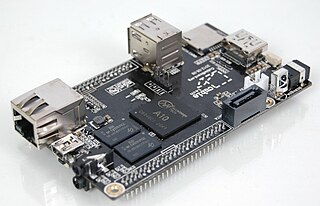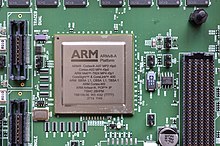ARM is a family of RISC instruction set architectures (ISAs) for computer processors. Arm Ltd. develops the ISAs and licenses them to other companies, who build the physical devices that use the instruction set. It also designs and licenses cores that implement these ISAs.

Tegra is a system on a chip (SoC) series developed by Nvidia for mobile devices such as smartphones, personal digital assistants, and mobile Internet devices. The Tegra integrates an ARM architecture central processing unit (CPU), graphics processing unit (GPU), northbridge, southbridge, and memory controller onto one package. Early Tegra SoCs are designed as efficient multimedia processors. The Tegra-line evolved to emphasize performance for gaming and machine learning applications without sacrificing power efficiency, before taking a drastic shift in direction towards platforms that provide vehicular automation with the applied "Nvidia Drive" brand name on reference boards and its semiconductors; and with the "Nvidia Jetson" brand name for boards adequate for AI applications within e.g. robots or drones, and for various smart high level automation purposes.
Rockchip is a Chinese fabless semiconductor company based in Fuzhou, Fujian province. Rockchip has been providing SoC products for tablets & PCs, streaming media TV boxes, AI audio & vision, IoT hardware since founded in 2001. It has offices in Shanghai, Beijing, Shenzhen, Hangzhou and Hong Kong. It designs system on a chip (SoC) products, using the ARM architecture licensed from ARM Holdings for the majority of its projects.

The ARM Cortex-A15 MPCore is a 32-bit processor core licensed by ARM Holdings implementing the ARMv7-A architecture. It is a multicore processor with out-of-order superscalar pipeline running at up to 2.5 GHz.

The Samsung Exynos, formerly Hummingbird (Korean: 엑시노스), is a series of ARM-based system-on-chips developed by Samsung Electronics' System LSI division and manufactured by Samsung Foundry. It is a continuation of Samsung's earlier S3C, S5L and S5P line of SoCs.

The ARM Cortex-A7 MPCore is a 32-bit microprocessor core licensed by ARM Holdings implementing the ARMv7-A architecture announced in 2011.

The Mali and Immortalis series of graphics processing units (GPUs) and multimedia processors are semiconductor intellectual property cores produced by Arm Holdings for licensing in various ASIC designs by Arm partners.

Cubieboard is a single-board computer, made in Zhuhai, Guangdong, China. The first short run of prototype boards were sold internationally in September 2012, and the production version started to be sold in October 2012. It can run Android 4 ICS, Ubuntu 12.04 desktop, Fedora 19 ARM Remix desktop, Armbian, Arch Linux ARM, a Debian-based Cubian distribution, FreeBSD, or OpenBSD.

Allwinner Technology Co., Ltd is a Chinese fabless semiconductor company specialized in mixed-signal systems on a chips (SoC). The company is headquartered in Zhuhai, Guangdong, China.
The ARM Cortex-A17 is a 32-bit processor core implementing the ARMv7-A architecture, licensed by ARM Holdings. Providing up to four cache-coherent cores, it serves as the successor to the Cortex-A9 and replaces the previous ARM Cortex-A12 specifications. ARM claims that the Cortex-A17 core provides 60% higher performance than the Cortex-A9 core, while reducing the power consumption by 20% under the same workload.
Heterogeneous computing refers to systems that use more than one kind of processor or core. These systems gain performance or energy efficiency not just by adding the same type of processors, but by adding dissimilar coprocessors, usually incorporating specialized processing capabilities to handle particular tasks.
This is a comparison of ARM instruction set architecture application processor cores designed by ARM Holdings and 3rd parties. It does not include ARM Cortex-R, ARM Cortex-M, or legacy ARM cores.
Qualcomm Kryo is a series of custom or semi-custom ARM-based CPUs included in the Snapdragon line of SoCs.
The ARM Cortex-A76 is a central processing unit implementing the ARMv8.2-A 64-bit instruction set designed by ARM Holdings' Austin design centre. ARM states a 25% and 35% increase in integer and floating point performance, respectively, over a Cortex-A75 of the previous generation.
The ARM Cortex-A77 is a central processing unit implementing the ARMv8.2-A 64-bit instruction set designed by ARM Holdings' Austin design centre. ARM announced an increase of 23% and 35% in integer and floating point performance, respectively. Memory bandwidth increased 15% relative to the A76.
The ARM Cortex-A78 is a central processing unit implementing the ARMv8.2-A 64-bit instruction set designed by ARM Ltd.'s Austin centre.
The ARM Cortex-X1 is a central processing unit implementing the ARMv8.2-A 64-bit instruction set designed by ARM Holdings' Austin design centre as part of ARM's Cortex-X Custom (CXC) program.

The Samsung Galaxy A12 is an Android smartphone manufactured by Samsung Electronics. This phone was announced in November 24, 2020 as a successor to the Samsung Galaxy A11.











